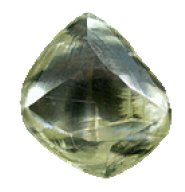
September Editorial
The Diamond as the eye to the centre of the Earth

September Editorial
The Diamond as the eye to the centre of the Earth
|
|
Diamonds have recently been at the centre of a number of geological studies, as can be seen by looking through past editorials. Now yet again it seems that diamonds have yet another long sought-after answer to a question about the geology of the Earth. This particular question is how the oceanic crust is recycled and ends up as newly-crystallized volcanic rocks. It is already established that partial melting of the Earth's mantle is important in the geochemical diversity of volcanic rocks on the surface of the planet. It is also known that the oceanic crust is continually renewed by magma from the mantle. Seismic imaging has shown that the oceanic crust can be subducted to depths of almost 3000km. The subduction zone is an area where two tectonic plates meet and move towards each other, with one sliding over the other one which moves down to into the mantle. The oceanic plates typically slide underneath the continental plate or another oceanic plate, often creating a so-called orogenic zone (from Greek: mountain creating) or volcanic arc in the land above - a movement which also translates into earthquakes. In the subduction zone, the sediments, oceanic crust and mantle lithosphere are mixed with mantle from the over-riding plate. This causes mantle melting in which the new melts are then released, creating fresh ore deposits and continental crust. Each melt has a unique composition which distinguishes it from the surrounding magmas. Although this general schema of events was postulated some time ago, the exact processes which take place at the subduction zones are difficult to study in detail. But if we could identify the composition of these primary melts, we would be much closer to understanding how the mantle reservoirs contribute to this geological process. However, the primary melt samples can not be obtained simply by drilling because the depths required are beyond the reach of even modern drilling technology. But a team of researchers at the University of Bristol, working alongside colleagues at the STFC Daresbury Laboratory, have found another way to get at the required data. Meet the diamonds of the Juina area of Brazil. These Brazilian diamonds have been particularly useful for this study because they contain a high degree of other mineral inclusions. To study the content of these inclusions, the scientists used an intense beam of x-rays. Of particular interest was calcium-titanium-silicate perovskite, which occurs in the Brazilian diamonds but does not occur naturally near the Earth’s surface. The term 'perovskite' relates to either a mineral with the chemical formula of CaTiO3 (calcium titanium oxide) or to any material with the same crystal structure as CaTiO3. The former was discovered in the Ural mountains of Russia by Gustav Rose in 1830 and was named after Russian mineralogist, L.A. Perovski. The general chemical formula for perovskite compounds is ABO3 where A and B are any two elements. For example pyroxene enstatite, a perovskite-structured polymorph of MgSiO3 which is one of the most common mineral on the Earth, is formed under high pressure conditions in the Earth's mantle. Earlier studies have shown that when polycrystalline samples in the CaTiO3–CaSiO3 perovskite system are heated to high temperature under high pressure they will create calcium-titanium-silicate perovskite such as Ca(Ti0.75Si0.25)O3 and Ca(Ti0.5Si0.5)O3 (Centre of High Pressure Research and Department of Earth and Space Sciences, State University of New York, 1998). Using X-ray diffraction techniques Dr M. J. Walterand his colleagues studied the relative amounts of different trace elements in the Brazilian diamonds. They found an inconsistency between the abundance of trace elements associated with the oceanic crust which coexisted with a calcium-titanium-silicate perovskite inclusion. Their observations suggest that for the diversity in inclusions found in the diamonds to be possible, the oceanic crust melts must have been subducted to the depth of at least 700 km within the mantle transition zone. At that depth the oceanic crust melts mix with liquid magma from the mantle before being recycled to the surface during volcanic eruptions. The full description of this study can be found in the July issue of Nature ('Primary carbonatite melt from deeply subducted oceanic crust' (2008), Nature 454 pp622-625). |
| _______________________________ | ||||
| Home | | | Shopping | | | Database |
© Biscuit Software 2004-2015
All rights reserved